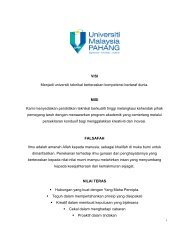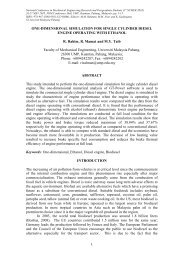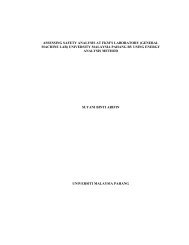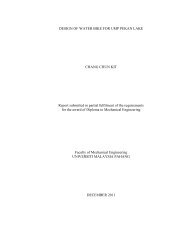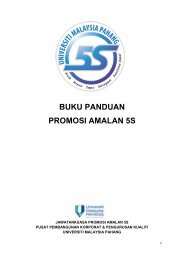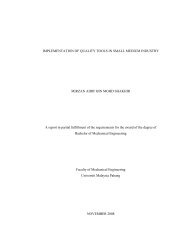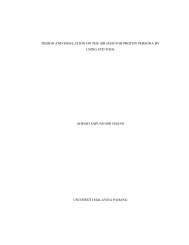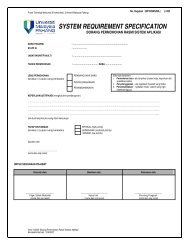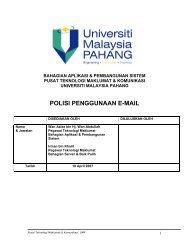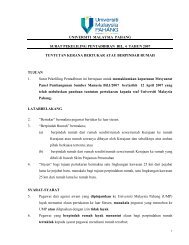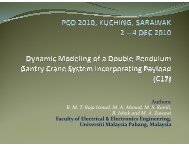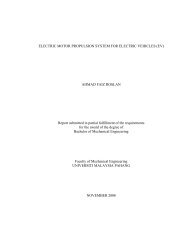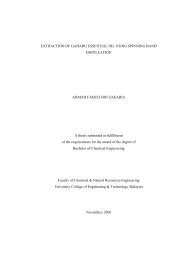ISOLATION OF MICROORGANISM FROM OIL PALM SAP NURUL ...
ISOLATION OF MICROORGANISM FROM OIL PALM SAP NURUL ...
ISOLATION OF MICROORGANISM FROM OIL PALM SAP NURUL ...
- No tags were found...
Create successful ePaper yourself
Turn your PDF publications into a flip-book with our unique Google optimized e-Paper software.
viiiABSTRACTThe oil palm sap is come from the oil palm trunk. The outer of the trunk isbeing process to become plywood but for the most moisture part, it has beensqueezed in order to get the sap. The unfermented sap is clean, sweet, colorless syrupcontaining about 10–12 % sugar, which is mainly. Sap also rich with other simplesugar such as glucose, fructose, raffinose, amino acid, vitamins and other essentialnutrients. This research is aim to isolate bacteria using streaking plate method frompalm oil sap and identified by using Bergey‟s manual. . A total of 15 colonies weresuccessfully isolated from the palm oil sap. From analysis, Lactobacillus spp. wasthe dominant species isolated followed by Pseudomonas spp., Corynebacterium sppand Vibro spp. For the kinetic growth study, the kinetic values that need todetermine are maximum growth rate (µ m ), decay coefficient (K d ), yield coefficient(Y) and substrate coefficient (K s ). The growth kinetic is calculated by measured thesubstrate concentration and biomass weight. K d was determined to be 0.034 h -1 and Yas 0.124 g/L. Meanwhile, µ m was 0.2532 h -1 and K s was 536.4557 g/L. As aconclusion, it is well known that the environment condition influence the bacteriaspecies and growth activities of bacteria.
ixABSTRACTSap kelapa sawit adalah berasal dari batang pokok kelapa sawit yangtelah diperah. Kebiasaannya, bahagian luar batang pohon kelapa sawit dijadikan papandan bahagian yang mempunyai kandungan air yang tinggi diperah bagi mendapatkan sapkelapa sawit. Sap segar mempunyai warna yang jernih, rasa manis dan mengandungi 10– 12% gula. Selain itu, sap kelapa sawit juga mengandungi gula ringkas lain sepertiglukosa, fruktosa, raffinose, asid amino, vitamin dan nutrien-nutrien baik yang lain.Kajian ini dijalankan bagi mengasing dan mengenalpasti bakteria yang terdapat dalamsap kelapa sawit tersebut. Kaedah yang digunakan bagi mengasingkan bakteria ialahdengan menggunakna kaedah „ streaking plate method’. Bagi tujuan mengenal pastibakteria pula, manual Bergey diaplikasikan. Sejumlah lima belas koloni berjayadiasingkan. Bakteria spesis Lactobacillus.dikenalpasti sebagai koloni dominan. Inidiikuti oleh bakteria spesis Pseudomonas, spesis Corynebacterium dan spesis Vibro.Bagi kajian menentukan pertumbuhan kinetik bakteria, nilai kinetik yang perlu dikiraialah ‘growth rate’ (µ m ), ‘decay coefficient’ (K d ), ‘yield coefficient’ (Y) dan ‘substratecoefficient’ (K s ). Berdasarkan pengiraan, nilai K d ialah 0.034 h -1 dan Y ialah 0.124 g/L.Manakala, nilai bagi µ m ialah 0.2532 h -1 dan K s ialah 536.4557 g/L. Kesimpulannya,keadaan persekitaran mempengaruhi kewujudan spesis dan pertumbuhan bacteria dalamsap kelapa sawit.
xi2.1.2 Microorganism from Oil Palm Tree 72.2 Cultivation of Bacteria 102.2.1 Nutritional Needs 102.2.1.1 Carbon 102.2.1.2 Nitrogen 102.2.1.3 Vitamin 112.3 Techniques for Isolation of Pure Culture 112.3.1 Streak-Plate Method 112.3.2 Spread-Plate Technique 122.3.3 Role Tube Method 132.3.4 Drop Plate Method 132.3.5 Membrane Filtrations 142.4 Characterization of Microorganism Isolates 152.4.1 Gram Staining Method 152.5 Growth Kinetics 162.5.1 Monod Kinetic Equation 162.5.1.1 Rate of Change For SubstrateConcentration 172.5.2 Contois Kinetic Equation 182.5.2.1 Rate of Change ofEffluent Biomass Concentration 182.6 Determination of the Kinetic Parameters 192.6.1 Determination of Y and K d 192.6.2 Determination of µ m and K S203 MATERIALS AND METHODS3.1 Introduction 223.2 Chemical and Biological Materials 243.3 Source of Inoculum 243.4 Autoclaving 24
xii3.5 Culture Medium 243.6 Isolation and Characterization of Bacteria. 253.7 Bacteria Identification 263.7.1 Preparation of Bacteria Smears 293.7.2 Gram Stain 293.7.3 Spore stain (Schaeffer-Fulton Method) 293.7.4 Acid – Fast stain(Ziehl – Neelsen Method) 293.7.5 Glucose Fermentation Activity 303.8 Determination of growth kinetic3.8.1 Microorganism 303.8.2 Medium and Culture Condition 303.8.3 Measurement of Cell Growth 313.8.4 Substrate analysis using DinitrosalicyclicColorimetric Method (DNS Assay) 314 RESULTS AND DISCUSSIONS4.1 Identification of Bacteria from Palm Oil Sap 324.2 Kinetic Coefficient 354.2.1 Determination of Y, K d , µ m & K S 365 CONCLUSION AND RECOMMENDATION5.1 Conclusion 405.2 Recommendation 41REFERENCES 42APPENDIX A 45
xiiiLIST <strong>OF</strong> TABLESTABLE NO. TITLE PAGE4.1 Biochemical Characteristic of the Gram-positive BacteriaStrain4.2 Biochemical Characteristic of the Gram-negative BacteriaStrain4.3 Kinetic coefficients of bacteria from various kind of palmsap.333338
xivLIST <strong>OF</strong> FIGURESFIGURETITLEPAGENO.1.1 Images of felled oil palm trunks and diagrams of sample 3preparation for analyses.2.1 Four-way streak-plate inoculation 122.2 Petri dish turntable 122.3 Generalized substrate consumption and biomass growth 19with time.3.13.23.33.4Research design for bacteria isolation and growth profilestudy of palm oil sap.Medium preparation (Nutrient Agar and Nutrient Broth)Streaking plate method procedure was done under sterilecondition in laminar flow.Colonies appear on culture medium after 24 hours25252526incubation3.53.63.73.84.1Bergey‟s Manual of Determative Bacteriology for GramPositive RodsBergey‟s Manual of Determative Bacteriology for GramNegative RodsFlood smear with malachite green and steam over a beakerof water placed on a hot plate.Substrate analysis using DNS assayGraph of specific growth rate, µ versus substrate utilizationrate, U2728293136
4.2 Graph of BRTG/ (1+BRTG.Kd) vs 1/S 37xv
xviLIST <strong>OF</strong> APPENDICE<strong>SAP</strong>PENDIX TITLE PAGEA1 Experiment Data for Kinetic Growth Study 45A2 Calculation on determination of Y, K d , µ m & K S 49
xviiLIST <strong>OF</strong> SYMBOLS/ABBREVIATIONSDNS - Dinitrosacyclicg - Gramg/l - Gram per litrehr - HourL - Litremg/mlMiligram per mililitreOD - Optical densityrpm - Round per minuteUv-Vis - Ultraviolet Visible Spectroscopyw/v - Weight per volume˚C - Degree Celsius% - Percentage
1CHAPTER 1INTRODUCTION1.1 Research BackgroundPalms are believed to be among the oldest flowering plants in the world(Redhead, 1989) There are various species of palm trees among which are Elaeisguineensis, Raphia regalis, R.sudanica, R.vinifera and R.hookeeri (Obire, 2005). The oilpalm is a tropical plant that grows in warm climates at altitudes below 500 meters abovesea level. Its introduction to tropical America is attributed to Portuguese colonizers andslave traders, who used it as part of the diet for their slaves in Brazil.Oil palm (Elaeis guineensis) for palm oil production needs to be replanted at aninterval of 20 to 25 years in order to maintain oil productivity. The plantation area inMalaysia and Indonesia in 2007 was 4,304,913 ha (Al Widyan, 2002) and nearly 7million ha respectively. Considering the replanting interval, 450,000 ha to 560,000 ha ofthe oil palm plantation area is expected to be replanted annually during the next 25years. This means on average 64 million to 80 million old palm trees will be felled everyyear in the two countries, as approximately 142 oil palms are usually planted in onehectare (Pramila and Subhash, 2007).For centuries, many palm species have been tapped throughout the tropical worldin order to produce fresh juice (sweet toddy), fermented drinks (toddy, wine, arak),syrup ("honey"), brown sugar (jaggery) or refined sugar. One of mankind's first sources
2of sugar was probably Arenga pinnata (Redhead 1989). Evidence of the use of Borassusflabellifer sugar in India has been reported by the Greek historian Megasthenes,ambassador to the court of Chandragupta, in the 4 th century BC. Hindus knew how toextract it about 4,000 years ago (Ferguson, 1888; Fox, 1977). Jaggery and treacleextracted from Caryota urens sap in Sri Lanka has been an important source of sugarfrom antiquity (Dissanayake, 1977). In Africa, the main traditional use of palm sap is forwine production. It has been reported in Egypt (date palm) long before the birth ofChrist (Barreveld, 1993) and on the Guinea coast by early navigators in the 15 th century(Sodah Ayernor and Matthews, 1971).The oil palm sap is come from the oil palm trunk. The outer of the trunk is beingprocess to become plywood but for the most moisture part, it has been squeezed in orderto get the sap (Yutaka et al., 2007). The unfermented sap is clean, sweet, colorless syrupcontaining about 10–12 % sugar, which is mainly sucrose (Bassir, 1962 : Okafar, 1975).Sap also rich with other simple sugar such as glucose, fructose, raffinose , amino acid ,vitamins and other essential nutrients (Okafar, 1978).This pure sap has a short life of stability because the condition of the sap is verysuitable for microorganisms to growth (fermentation). The presence of variousmicroorganism especially bacteria and yeast responsible for the fermentation of palmwine(Bassir, 1962 ; Faparusi, 1966 ; Okafar, 1977). So, the sugar level of the sap willdecrease rapidly due to the fermentation by the natural microbial flora and converted toalcohol and other products. The types of bacteria present appear are depends on the stageof fermentation and the composition of the sap (Bassir, 1962 ; Okafar, 1977).
31.2 Problem StatementPalm oil production has been documented as a cause of substantial and oftenirreversible damage to the natural environment. Most researcher nowadays werefocusing on the study of empty fruit bunch or POME, however less research were doneto investigate other part from the palm oil tree itself. In major practices, palm sapusually were fermented to be used as traditional drink which known as palm wine. InAfrican society, palm wine has a significant role in customary practices. Generally,both brands of palm wine have several nutritional, medical, religious and social useswhich have been reported else where (Faparunsi, 1966; Odeyemi, 1977; Ikenebomehand Omayuli, 1988; Uzogara et al.,1990; Iheonu, 2000), to have increasingly enhancedthe demand for this natural product. Sugars in the sap of the felled trunk and observed alarge quantity of high glucose content sap in the trunk. Studies over the years have beendeboted to the isolation and identification of the microorganism responsible for variousfermentation processes.Figure 1.1: Images of felled oil palm trunks and diagrams of sample preparation foranalyses. (A) Felled trunks carried to a plywood factory. (B) A disk taken from a trunk.(C,D) Disks were cut into inner (a), middle (b), and outer (c) parts.
41.3 Objectivei. This research is aim to isolate bacteria using streaking platemethod from palm oil sap.ii. Determine the kinetic models values of bacteria mix culture frompalm oil sap.1.4 Research Scopeobjective:There are research scopes that have been identified for this study to achieve thei. To isolate the bacteria from the oil palm sap using the streaking platemethod.ii. To identify bacteria colonies by using Bergey‟s manual.iii. To study the growth kinetics of bacteria mix culture from oil palm sap byusing Monod Kinetic Model. The kinetic values that need to determineare maximum growth rate, decay coefficient, yield coefficient andsubstrate coefficient. The growth kinetic is calculated by measured thesubstrate concentration and biomass weight.
51.5 Rational And SignificantPalm sap is the tropical plants of the palmae family. It is produced and consumedin very large quantities in the southeastern Nigeria. It contains nutritionally importantcomponents including amino acids, proteins, vitamins and sugars (Okafor, 1987). Thesemake this sap a veritable medium for the growth of a consortium of microorganisms,whose growth in turn, change the physicochemical conditions of the wine, giving rise tocompetition and successions of organisms. Many workers have indeed carried outstudies aimed at isolating and exploiting palm wine yeasts for industrial processes.These include for baking, portable ethanol production and single cell protein production.
6CHAPTER 2LITERATURE REVIEW2.1 Plant SapPlant sap is distinct from nectar and latex as well as from the gum and resin thatsap carry (David, 1989). Sap is aqueous, tends to have a high pH, and is carried in plantxylem or phloem. Xylem sap tends to have lower sugar concentration than that ofphloem (Darkee, 1983). The sugar content of phloem primarily sucrose and from asample of 500 trees species, ranged from 1%-30% in concentration (Zimmerman andZiegler, 1975). In addition to carbohydrate, phloem sap contain some amino acid,proteins, vitamins, salts and elemental metals (Chino et al., 1982 ; Richardson, BakerandHo , 1982 ; Stemmer et al., 1982 ; Simpson and Neff, 1983). Notably, the sap in theinner part of the trunk accounted for more than 80% of the whole trunk weight.2.1.1 Oil Palm (Elaeis guineensis) SapOil palm (Elaeis guineensis) is widely planted for its edible oil in tropicalcountries such as Malaysia and Indonesia. The production of palm oil is 39 Mt per yearin 2007, which is the most produced plant oil in the world (H.Yamada et al., 2010). Theoil is mainly used for food and related industries, and is also used as a raw material forvarious products such as detergents and cosmetics. Moreover, a number of researchstudies have been carried out for biodiesels and bio-plastic materials from the oil in
7recent years (Chongkhong et al., 2007; Tanaka et al., 2008; Kalam et al., 2002; Al-Widyan et al., 2002; Pramila.T et al., 2007).It has been traditionally practiced to produce palm sugar and palm wine usingsap obtained by tapping the inflorescence of various species of palms including Arengapinnata, Borassus flabellifer, Cocos nucifera, Nypa fruticans and oil palm (Dalibard C,1999). Among these palm species, oil palm is considered to produce much smalleramount of tapped sap, or low sugar yield (Niger J, 1987). Oil palm sap was reported tocontain approximately 11% sugars with sucrose as a major component accounting forapproximately 90% of total sugar (Eze MO and Ogan AU, 1988). Oil palm sap wasfound to be rich in various kinds of amino acids, organic acids, minerals and vitamins.2.1.2 Microorganism from Oil Palm TreePrevious studies on the microbiology of oil palm tree (E. guineensis) and R.hookeri have incriminated several bacterial and yeast flora to be involved in thefermentation process (Faparunsi and Bassir, 1972a; Okafor, 1972ab; Okafor, 1975b; Ezeand Ogan, 1987; Amanchukuru et al., 1989; Ejiofor, 1994; Orimaiye, 1997; Nester etal., 2004). These organisms have also been reported to originate from several sources,which include tapping equipment, containers and the environment (Faparunsi andBassir, 1972a; Eapen, 1979).During fermentation, the sugars in the palm-sap are metabolized to alcohol andorganic acids with the result that the sap loses its sweetness (Okafor, 1975). The types ofbacteria present appear to depend on the stage of fermentation and the composition ofthe sap (Bassir, 1962; Okafor, 1977). Although alcohol production is common amongyeasts, it is rare among bacteria (Ingraham and Ingraham, 2004). Yeasts are used tomake most alcohol beverages. But pulque is an exception. Pulque is an alcoholicbeverage from the juice of the agave plant fermented by Zymomonas mobilis (Talaro andTalaro, 1999; Ingraham and Ingraham, 2004).
8Acetobacter species were earlier isolated from oil palm wine (Faparusi and Basir,1972; Faparusi, 1973; Okafar, 1975) and from immature spadix of palm tree (Faparusi,1973). A. pasteurianus was isolated from palm wine (Simmonart and Laudelout, 1951),and A. aceti subp. Xylinium from the leaflets of the palm tree and the surrounding air(Faparusi, 1973). The strains of acetic acid bacteria are useful for vinegar production;however, lack of defined pure starter cultures is due to problems in strain isolation,cultivation and preservation of vinegar bacteria (Kittleman et al., 1989; Sievers et al.,1992; Sokollek and Hammes, 1997). Acetic acid bacteria are able to produce highamounts of acetic acid from alcohol. Furthermore, these bacteria can produce othercompounds, apart from acetic acid, that can influence wine quality (Drysdale and Fleet,1989a). Earlier research has also shown that acetic acid bacteria (genera Acetobacter andGluconobacter) were able to produce some polysaccharides such as cellulose, levan anddextran (Hibbert and Barsha, 1931; Loitsyanskaya, 1965; Hehre and Hammilton, 1953).In Mexico, the distilled spirit tequila is traditionally made from the fermentationof juices from the agave plant using the bacterium Z. mobilis (Ingraham and Ingraham,2004; Nester et al., 2004). Zymomonas species are perhaps the most important alcoholicfermenters of the bacterial group in plant saps and juices. Zymomonas are facultativeaerobes with both respiratory and fermenting capabilities. As inyeast, Zymomonas decarboxylates pyruvate non oxidatively with the formation ofacetaldehyde; which is subsequently reduced to ethanol by the Entner-Doudoroff‟spathway (Swings and De Ley, 1977; Talaro and Talaro, 1999; Ingraham and Ingraham,2004). The production of acetaldehyde and the characteristic fruity odourof Zymomonas also contribute to the odour and taste of wines (Swings and De Ley,1977; Ingraham and Ingraham, 2004).Lactic acid bacteria (LAB) are recognized as having important roles in thefermentation and preservation of a great variety of food and feed, while the roles ofacetic acid bacteria (AAB) in the development of the vinegary taste in palmwine havealso been investigated (Amoa-Awua et al., 2006). LAB and AAB have been found athigh levels, while the yeast species S. cerevisiae and Schizosaccharomyces pombe have
9been reported to be the dominant yeast species (Odunfa and Oyewole, 1998). However,other yeast species have also been found, such as Kloeckera apiculata, Candida krusei,and other Candida sp., Pichia sp. (Atacador-Ramos, 1996; Amoa-Awua et al., 2006).The difficulty of storing palm-wine to retain its normal characteristics due to thefermentative ability of probably Zymomonas species and other microorganisms presentin the wine has been a major problem in the bottling of palm-wine in Nigeria andconsequently its distribution for consumption (Obire O, 2005). In addition to theirfermentative ability, Zymomonas species are known to be harmless to man and cattle.Some of its fermentation products are found useful in the treatment of various diseasesranging from chronic enteric metabolic disorders to gynecological infections (Swingsand De Ley, 1977). The presence of Zymomonas species in palm-wine may thus bebeneficial to man. Other components in the squeezed sap that may affect fermentation,namely, amino acids, organic acids, minerals and vitamins.In recent years, culture-independent methods based on molecular biologytechniques have been developed to study microbial population dynamics. Today,culture-independent methods are particularly attractive, as they provide a good and rapidstrategy for yeast detection, and they represent a valid alternative to classicalmicrobiological analyses. In addition, culture-independent analysis offers the possibilityof detecting species that may be present in the habitat at viable, but non-culturable,levels (Head et al., 1997; Rappe and Giovannini, 2003; Ercolini, 2004). Indeed, classicalmicrobiological methods based on plate counts, and isolation and biochemicalidentification have been criticized, since only easily culturable microorganisms can bedetected, and members of microbial communities that need elective enrichment are notidentified.
102.2 Cultivation of BacteriaAs do all other living organisms, microorganism require certain basic nutrientsand physical factors for the sustenance of life. However, their particular requirementsvary greatly.2.2.1 Nutritional Needsmedia.Nutritional needs of microbial are supplied in the laboratory through a variety of2.2.1.1 CarbonCarbon is the most essential and central atom common to all cellular structuresand functions. Among microbial cells, two carbon-dependent types are noted, autotrophsand heterotrophs.2.2.1.2 NitrogenNitrogen also an essential atom in many cellular macromolecules, particularlyproteins and nucleic acids. Proteins serve as the structural molecules forming the socalledfabric of the cell and as functional molecules, enzymes, that are responsible forthe metabolic activities of the cell. Nucleic acid include DNA, the genetic basis of celllife, and RNA , which plays an active role in protein synthesis within the cell.
112.2.1.3 VitaminBesides, vitamin, organic substances contribute to cellular growth and areessential in minute concentrations for cell activities. some microbes requires vitamin fornormal metabolic activities. Some possess extensive vitamin-synthesizing only a limitednumber from other compounds present in the medium.2.3 Techniques for Isolation of Pure CultureIn nature, microbial population do not segregate themselves by species but existwith a mixture of many other cell types. These population can be separated into pureculture. These culture contains only one type of organism and are suitable for the studyof their cultural, morphological, and biochemical properties. The techniques commonlyused for isolation of discrete colonies initially required that the number of organisms inthe inoculum be reduced (James and Natalie, 7 th ed., microbiology laboratory manual)2.3.1 Streak-Plate MethodThe streak-plate is a rapid qualitative isolation method. It is essentially a dilutiontechnique that involves spreading a loopful of cultures over the surface of an agar plate.The four-way or quadrant streak is preferred.
12Figure 2.1: Four-way streak-plate inoculation2.3.2 Spread-Plate TechniqueThe spread plate techniques required that a previous diluted mixture ofmicroorganism be used. During inoculation, the cells are spread over the surface of asolid agar medium with a sterile, L-shaped bent rod while Petri dish is spun on a “lazy-Susan”turntable.Figure 2.2: Petri dish turntable
132.3.3 Role Tube MethodRoll tubes are test tubes with a nutrient medium solidified in a thin layer aroundthe inner surface of the tubes. The roll tube, as originated by Esmarch (E.1886), has notbeen a popular system for the isolation and enumeration of bacteria since the availabilityof petri dishes. However, a rolltube method for counting bacteria in milk is still used(American Public Health Association. 12 th ed., 1967 ).Esmarch used roll tubes for anaerobic culturing by filling the hollow core with asolid medium, and Frankel (Frankel, 1888) and Ewell (Ewell, 1897.) used hydrogen gasmethods to reduce the medium after sterilization. These methods were replacedprincipally by petri plates used with anaerobic jars.Roll-tube methods allow cultivation of fastidious anaerobes that have not beensuccessfully cultured by petri plate and anaerobic jar methods (Hungate, R. E. 1950 ;Hungate, R. E. 1966 ; Spears, R. N., and R. Freter. 1967). Roll-tube techniques havebeen used to study the rumen of herbivores and, as a result, the rumen is now the bestecologically understood anaerobic microbial habitat.Roll-tube anaerobic counts have been compared to standard anaerobic jar platecounts by using normal flora of animals and man (Spears, R. N., and R. Freter. 1967;M.Stutman and D. F. Gordon, Jr., Int. Ass. DentalRes. Abstr. 181, p. 86, 1969), and theroll-tube method has always given a significantly higher count.2.3.4 Drop Plate MethodThe drop plate (DP) method exhibits many positive characteristics. The platingand counting procedures require less labor than alternative methods. The plating andcounting steps are very convenient and manageable. On appropriately dried plates, thedrops will absorb quickly into the agar. By distributing the sample in drops, colonycounting can be done faster and perhaps more accurately.
14The drop plate method expends relatively few supplies. A bibliographic-databasesearch and a worldwide web search showed that the drop plate method is being used innumerous laboratories across the world. In spite of its widespread use, the DP methodhas not been standardized. Accurate and precise measurement of the drop volume isabsolutely necessary to the DP method.Donald 1915 was the first to describe a method for the precise measurement offluid volume by means of drops. The DP method is a mixture of microbiologicalcomponents and design components.2.3.5 Membrane FiltrationsMembrane filtration usually used for isolation of microorganism from surfacewater samples. In recent research, evaluation of membrane filters application were usedto isolated Leptospira from surface water samples. The filter materials evaluatedincluded nitrocellulose (0.22 and 0.45 μm pore diameters), polyvinylidene fluoride(Durapore 0.22 and 0.40 μm pore diameters), nylon mesh (37 μm), and glass fiber (1.0μm). Millipore polyvinylidene fluoride filter (0.22 μm) was examined by scanningelectron microscopy to verify that leptospires were present following filtration (KaboosiH, Razavi M.R and Noohi, 2005).
152.4 Characterization of Microorganism IsolatesThe isolates were grouped accorded to their colonial morphology and cellcharacteristics. The colonies were counted and re-isolated in pure culture using themedium on which they had grown as described by Njoku et al. (1990). Isolates werethereafter subjected to biochemical tests as described by Collins and Lyne (1984) andOgbulie et al. (1994). The probable identities of the isolates were determined asrecommended by Bergey‟s manual.2.4.1 Gram Staining MethodThe Gram stain was developed by Christian Gram in 1884 and modified byHucker in 1921. The Gram stain is a differential stain that allows classifying bacteria aseither gram-positive or gram-negative. Gram-positive microorganism that retain theprimary dye (Crystal violet) and Gram-negative microorganism that takes the color ofthe counterstain (usually Safranin). These result are due to the differences in thestructure of the cell wall. Crystal violet is attracted to both Gram-positive and Gramnegativemicroorganism. The second step (Gram‟s Iodine) stabilizes the Crystal violetinto the peptidoglycan layer of the cell wall. The peptidoglycan layer is much thicker inGram-positive bacteria than in Gram-negative bacteria. Hence the Crystal violet is moreextensively entrapped in the peptidoglycan of Gram-positive bacteria. The third step(alcohol decolorization) dissolves lipids in the outer membrane of Gram-negativebacteria and removes the Crystal violet from the pepridoglycan layer. In contrast, theCrystal violet is relatively inaccessible in Gram-positive microorganism and cannotreadily be removed by alcohol in Gram-positive microorganisms, after the alcohol step,only the colorless Gram-negative microorganism can accept the Safranin, Carbolfuchsin,and Basic-fuchsin are sometimes employed in the counterstain to stainanaerobes and other weakly staining Gram-negative, including Legionella spp.,Campylobacter spp., and Brucella spp. (Emanuel G and Lorrence H.G, 2009).



